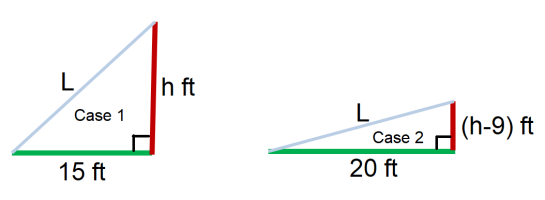You are using an out of date browser. It may not display this or other websites correctly.
You should upgrade or use an alternative browser.
You should upgrade or use an alternative browser.
Length of ladder: A ladder leans against a wall with its base 15 ft from it. When the ladder is pulled 5 ft further from the wall...
- Thread starter sweet$
- Start date
- Joined
- Feb 4, 2004
- Messages
- 16,550
A ladder leans against a wall with its base 15 ft from it. When the ladder is pulled 5 ft further from the wall, the upper end slides down 9 ft. How long is the ladder?
The ladder is the hypotenuse of the right triangle formed by the wall, the floor, and the ladder. So what Theorem holds for the length L of the ladder, the original height h of the top of the ladder, and the 15 feet of floor? Once you pull the ladder a bit further from the wall, what Theorem still applies to the (fixed) length L of the ladder, the new height h - 5 of the top of the ladder, and the 20 feet of floor?
helpermonkey
New member
- Joined
- Dec 29, 2023
- Messages
- 4
You basically have two triangles
using Pythagoras
the first one can be described as
x^2 ( height of ladder ) + 15^2 = y^2 ( length of ladder squared or hypotenuse squared)
so x^2 + 15 ^2 = y^2
the second triangle is
(x-9)^2 + ( 15 + 5) ^2 = y^2 ( as length of ladder never changes )
so both equations equate to y^2
so make equation one equal to equation 2
x^2 +15^2 = ( x-9)^2 + 20^2
x^2 + 225 = 400 + x^2 - 18x +81
cancel out the x^2
225 - 400 - 81 = -18x
x =
you can take it from there!
using Pythagoras
the first one can be described as
x^2 ( height of ladder ) + 15^2 = y^2 ( length of ladder squared or hypotenuse squared)
so x^2 + 15 ^2 = y^2
the second triangle is
(x-9)^2 + ( 15 + 5) ^2 = y^2 ( as length of ladder never changes )
so both equations equate to y^2
so make equation one equal to equation 2
x^2 +15^2 = ( x-9)^2 + 20^2
x^2 + 225 = 400 + x^2 - 18x +81
cancel out the x^2
225 - 400 - 81 = -18x
x =
you can take it from there!
helpermonkey
New member
- Joined
- Dec 29, 2023
- Messages
- 4
Just to say the only thing that makes you good at maths is the amount of time you put in to answering questions - you can see a lot of explanations of a problem but unless you try answering them on your own you don’t know if you’ve full understood the method used
mathematics is like any subject you should fully understand one topic before moving on to the next as the new topic will have elements that require you to have fully understand the previous one before and so on
mathematics is like any subject you should fully understand one topic before moving on to the next as the new topic will have elements that require you to have fully understand the previous one before and so on
The Highlander
Senior Member
- Joined
- Feb 18, 2022
- Messages
- 1,195
The situation has been summarized in words for you above (except that the "new height" should be: h - 9, not "h - 5") but it's often better if you start by drawing a sketch of the two cases.A ladder leans against a wall with its base 15 ft from it. When the ladder is pulled 5 ft further from the wall, the upper end slides down 9 ft. How long is the ladder?
In the diagram below (qv), the ground is (grassy) green, the wall is (brick) red and the ladder is (steely) blue.
Now, the length of the ladder is constant (ie: the same length in both cases) but it forms the hypotenuse of a right-angled triangle in both cases, therefore, we can state that, by Pythagoras' Theorem,:-
\(\displaystyle \textsf L^2 = 15^2 + \textsf h^2\) (in Case 1)
and
\(\displaystyle \textsf L^2 = 20^2 + (\textsf h - 9)^2\) (in Case 2)
and
\(\displaystyle \textsf L^2 = 20^2 + (\textsf h - 9)^2\) (in Case 2)
but, since L has the same value (length) in both cases, we can equate these two expressions for L to give us that:-
\(\displaystyle 15^2 + \textsf h^2 = 20^2 + (\textsf h - 9)^2\)
If you now expand the brackets [for (h - 9)2] you can simplify then solve this equation to get a value for h which will, in turn, allow you to calculate the length of the the ladder (L), again using Pythagoras' Theorem.
NB: Be sure to check that, once you have a value for h, you get the same value for L in both cases.
Please now come back and show us your work (including your own sketch?) and the value you get for the length of the ladder, thank you.
Hope that helps.
Last edited:

